K-3 / ROCK-1. The first air ambulance of the USSR
In the spring of 1927, the leadership of the RCSC proposed the development of a specialized ambulance aircraft capable of transporting patients, as well as providing a doctor. The Red Army Military Medical Administration became interested in this proposal and supported it. Soon there was a real order to create a new model of special-purpose aviation technology. The development and construction of the ambulance plane was entrusted to the Kharkov Aviation Plant.
A few months before, a new employee, Konstantin Alekseevich Kalinin, came to the design office of the Kharkov plant. Previously, he worked at the Kiev aircraft factory, where he developed and built a cargo-passenger aircraft K-1. Then the process of its modernization began, which included the improvement of the airframe and power plant. In accordance with the new order, namely KA Kalinin and his colleagues were to create a promising ambulance plane for the army and the Red Cross Society.
There were specific requirements for a promising car. The aircraft was supposed to show high take-off and landing characteristics, combining them with sufficient flight data. He had to sit on unprepared small platforms and take off from them. In the passenger cabin it was necessary to create comfortable conditions, place seats for patients, as well as install various devices and medical supplies. As it soon turned out, creating an aircraft that meets such requirements is not the easiest task.
The new project of the specialized aircraft received the factory designation K-3 - “Kalinin, the third”. Later, after the transfer to the customer, the car received a new name ROKK-1, indicating the operator. The pilots and doctors who worked with the plane, called him "Nurse."
The project manager was himself K.A. Kalinin. A great contribution to the solution of the main tasks was made by engineer and pilot Alexey Nikolaevich Gratsiansky. In one way or another, all other designers from the Kharkov Aviation Plant Bureau participated in the project.
The development of the future K-3 started with a search for a suitable platform. The designers decided not to build the plane from scratch and make it a modification of one of the existing machines. The existing project K-1 complied with the requirements for flight performance, and also allowed to place space for people and goods. Thus, the design of a promising ambulance aircraft was actually reduced to the restructuring of the internal volumes of the serial machine.
However, the processing of the cabin was a very difficult task. Sitting patients and a doctor could be placed in regular cab seats, but for stretchers with recumbent equipment, specialized equipment was required. There was a need for the means of their attachment, as well as a new special hatch. The stretcher simply did not pass through the side door, and their turn inside the aircraft was not possible. As a result, the designers had to look for new solutions and ideas. They were able to find a simple and successful solution to an actual problem, which, moreover, did not require serious processing of the airframe.
From the point of view of design, the new K-3 aircraft most closely resembled the previous K-1. In this case, it used some of the ideas of the K-2 project - the all-metal version of the base sample. The future "nurse", like its predecessors, was a single-engine aircraft, built according to the normal aerodynamic design with a highly elliptical wing in the plan with struts. The airframe design was traditional for the aircraft of that time. A frame built of wooden and metal parts was used, on top of which metal and linen sheeting were placed.
Designers retained the existing fuselage, built on the basis of a metal frame and reinforced with metal cables. The engine compartment and both cabins had a rigid metal lining, while the tail boom was covered with a canvas. The nose of the fuselage frame was a motor mount, covered with a metal casing. Behind her was a double cabin crew. The central part of the fuselage was given under the cabin for passengers. The tail rail remained mostly empty. It contained only control wiring cables and some other devices.
The plane received an elliptical wing in plan, the power set of which was assembled only from wooden parts. The refusal of a metal or mixed design was due to ease of manufacture and repair. The wing center section was connected to the curved upper part of the fuselage. In the root of the wing provided two fuel tank. In the center of the console there were attachment points for the struts. Wing mechanization included only ailerons with cable wiring.
The tail plumage was borrowed from the K-1. It included an elliptical stabilizer with elevators and a complex shaped keel. Its fixed part was made in the form of a trapezoid with a rounded front edge. On it was fixed a larger L-shaped rudder. The plumage was made of wood and linen. Steering was carried out with the help of cables. It is curious that the cable wiring took place near the roof of the fuselage, and near the center section its small section was outside the aircraft.
In the nose of the aircraft was a BMW-IV liquid-cooled gasoline engine rated at 240 hp. On the motor shaft was installed a wooden two-bladed screw of constant pitch. The engine was cooled using an oil radiator mounted on a motor mount and two onboard pull-out water radiators. A recognizable feature of the KA aircraft. Kalinina became a high and curved exhaust pipe, with the help of which gases were discharged upward from the glazing of the cabin.
The aircraft received a non-retractable landing gear. With the help of several struts under the fuselage bottom axis was fixed for mounting the wheels. In winter, the wheels were proposed to replace skis. To prevent unacceptable movements of the ski were completed with spring stretch. There was a spring-loaded crutch in the tail of the plane. It could also be equipped with its own ski.
The crew consisted of two people. The pilot and flight mechanic were located in their own cabin behind the engine compartment. Early aircraft mark "K" had a characteristic cockpit glazing. The windshield was actually part of the center section and provided limited forward vision. There were also two polygonal side windows. The pilots were located above the bottom of the fuselage, and under them provided the luggage compartment with access through the side hatch.
The “nurse” had a recycled cargo and passenger cabin. The entire central part of the fuselage represented the total volume for the transport of patients, doctors and medicines. The cabin was sheathed with sound and heat insulating felt material and equipped with a heating system with heat removal from the engine. The cabin casing, like all special equipment, could be cleaned and disinfected without the risk of damage. There were electric lights and fans for airing. The updated cabin had five rectangular windows in each side. Access to it was provided by a door on the starboard and a special hatch on the left.
Mounts for stretchers of the AF system were provided at the left side of the cabin. Lingart One of the sets of fixtures was above the floor, the second - in the middle of the height of the cabin. The plane could take on board two bedridden patients. For their loading there was a special hatch. Behind the cabin in the frame of the aircraft was organized by the "tunnel", and on the left side there was a lifting hatch. Through such a hatch, the stretcher could be placed on the plane, and then they were pulled into the cabin, where they were placed on the bindings. In the absence of a stretcher, four folding chairs could be used for sedentary patients.
On board the aircraft was to attend a doctor. His chair was in the back of the cabin. Behind him was a cabinet for medicines and instruments. A balloon with compressed air was also transported there. In the cockpit, we managed to find a place for tanks with hot and cold water, as well as a sink with a sink outside the aircraft.
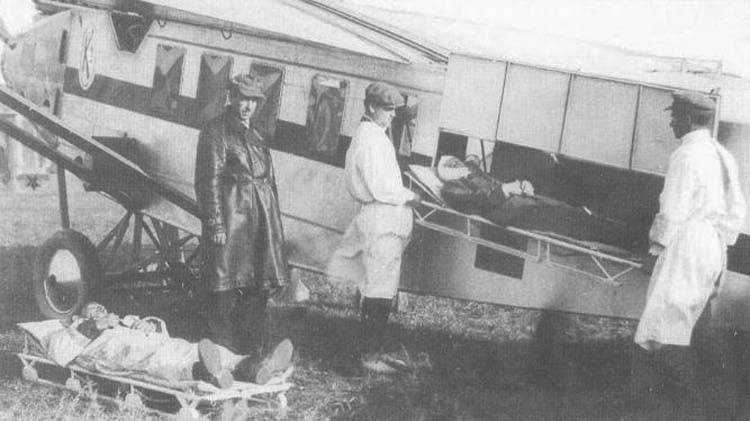
The process of loading a conditional wounded. The works are monitored by KA himself. Kalinin. Photo Airwar.ru
The K-3 aircraft maintained the dimensions of the base K-1. The length of the vehicle was 11,25 m, wing span - 16,7 m, height - 2,8 m. Wing area - 40 sq.m. Recycling the airframe led to some reduction in dry matter, which now was 1560 kg. The maximum take-off weight is 2,3 t. At that, 340-350 kg of payload were present on board, including the doctor and patients. Cruising speed was 140 km / h, maximum - 170 km / h. The practical ceiling was limited not only by the characteristics of the aircraft, but also by risks for passengers, as a result of which it reached only 880 m. Practical range - 730 km.
The Kharkov Aviation Plant spent only a few weeks on the development of the K-3 project. At the beginning of summer 1927, the project was presented to customers. The Russian Red Cross Society and the Military Health Administration approved the proposed look of the aircraft and started its construction. For several reasons, the assembly of the future ambulance took several months. To test it was possible to withdraw only in October. Soon, the necessary ground tests were carried out, and the X-NUMX of October, the X-NUMX of the year, the K-30, took off for the first time. The "nurse" was built on the basis of a serial machine, and therefore did not need serious and lengthy fine-tuning.
In early December of the same year, K-3 flew from Kharkov to Moscow on a ski landing gear, where demonstration flights and a new test phase took place. Representatives of various health services and medical institutions participated in some flights. The flight characteristics did not cause any complaints, and the equipping of the new cabin became an occasion for enthusiasm. The press called the aircraft K-3 a great victory for Soviet aviation technology.
March 4, 1928 the K-3 aircraft, by this time included in the squadron “Our answer to Chamberlain”, took part in the celebrations at the Central Airfield of Moscow. The plane was handed over to the air the fleet for introduction into full operation. After delivery, the car received a new designation - ROCK-1. She was to serve in the forwarding corps of the Office of the Sanitary Service. It was assumed that the Nurse will operate flights in different regions, depending on the emerging need.
Active operation of the first and, as it turned out, the only K-3 aircraft lasted for several years. The first patients took the plane at the beginning of 1928, and the last such operations took place in 1931. According to known data, in about three years, the Nurse has helped three dozen patients from different cities and regions. For the air ambulance of the time, this was an outstanding result. At the same time, assisting specific people, the country's first specialized ambulance plane clearly demonstrated the need to build a new technology of its class.
Shortly after the K-3 / ROKK-1 was commissioned, in April 1928 of the year, an order was received for the construction of two new airplanes. However, the Red Cross Society and the Military Health Administration decided to build this equipment on a different platform. In November, the 1928 of the year, the first of the two ordered aircraft, the K-4C, was put to trial. The newest aircraft K-4 had advantages over K-1, and therefore was a more profitable platform for specialized equipment. At the beginning of 1929, two K-4C aircraft joined ROKK-1 and took over part of his work. At the same time, air ambulance had the opportunity to reduce the role of other existing aircraft that do not carry special equipment.
The operation of the ROCK-1 / K-3 continued until the 1931 year. By this time, not the most technically advanced aircraft managed to develop a resource, as well as morally obsolete. The first in the country had to write off the ambulance. Unfortunately, soon a unique plane went for disassembly. Now it can be seen only in the preserved photographs of low quality.
The first Soviet specialized ambulance aircraft K-3 or ROKK-1 was developed in the shortest possible time and soon entered service. For several years of service, this machine managed to take part in a large number of rescue operations and transport several dozen patients. Quite quickly, two improved K-3С joined the first K-4, and in the future new types of specialized aircraft appeared regularly in our country. The operation of the only K-3 lasted only a few years, but it was she who started the construction of a full-fledged mass air ambulance of the USSR.
Based on:
http://airwar.ru/
http://aviadejavu.ru/
http://aviahistory.ucoz.ru/
https://rostec.ru/
Shavrov V.B. History designs of aircraft in the USSR before the 1938 year. - 3-ed. - M .: Mashinostroenie, 1986.
Savin V. K-brand aircrafts // Model-designer: magazine. - 1990. No. 7.
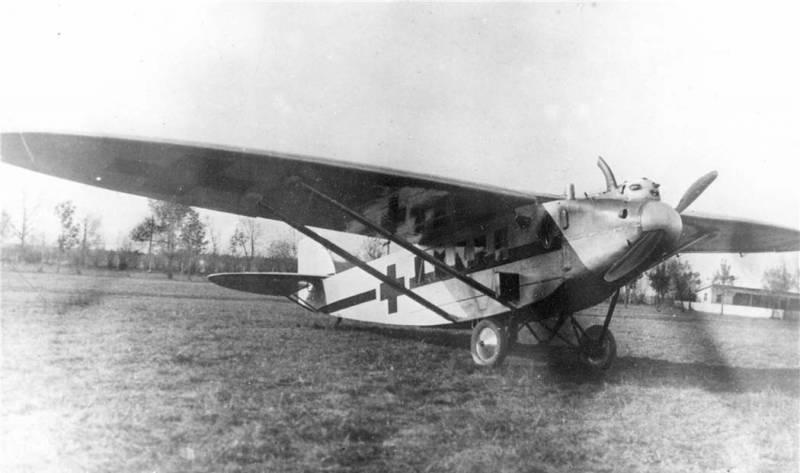

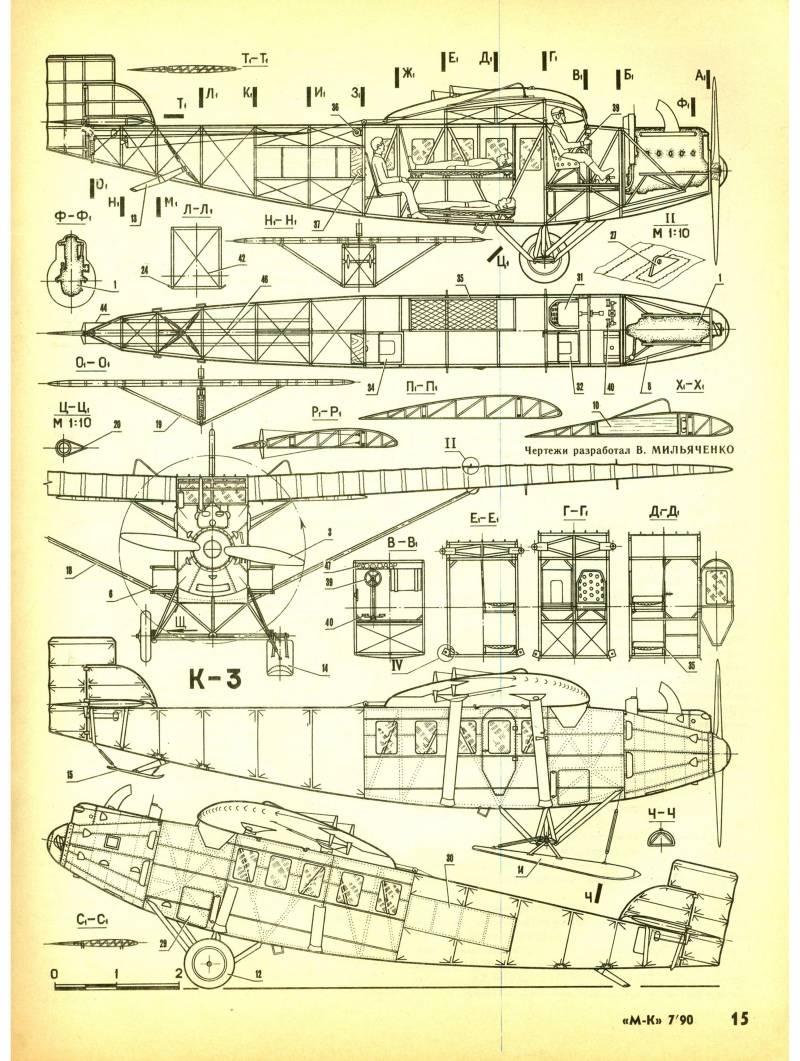
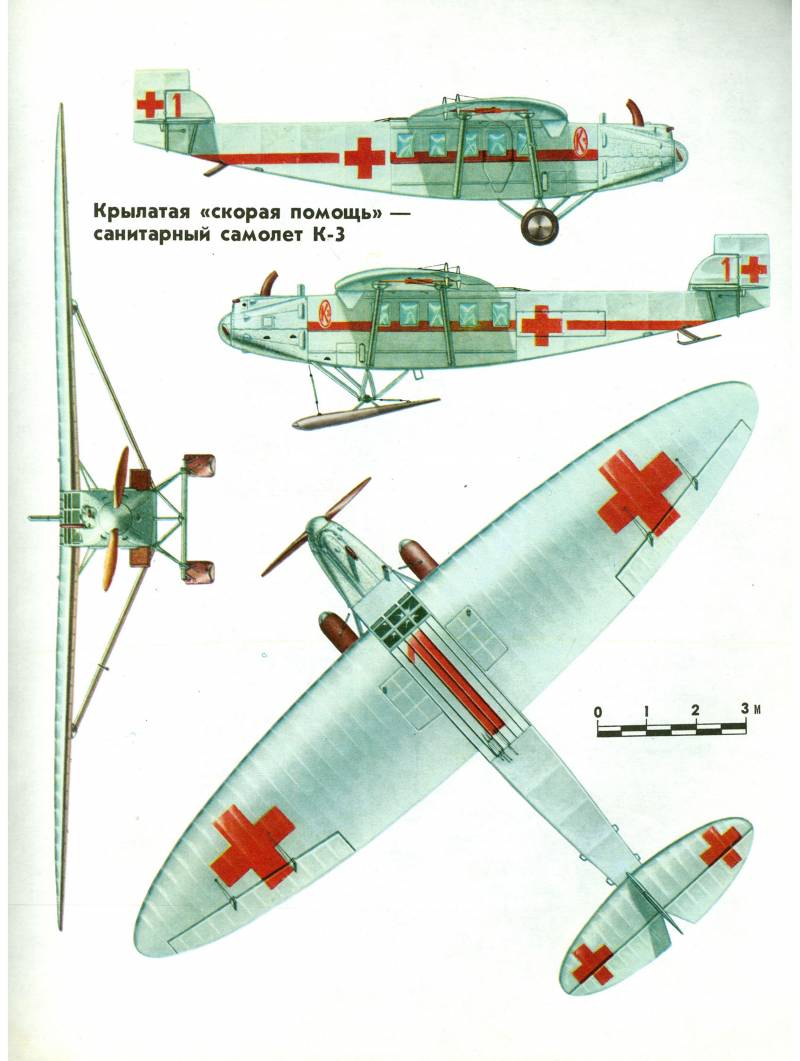
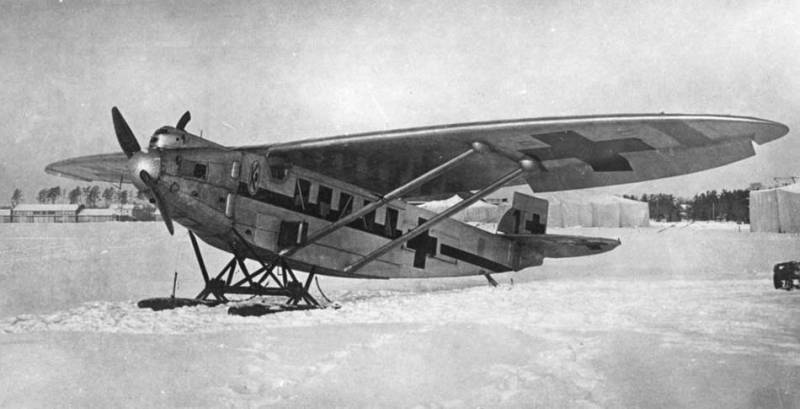
Information